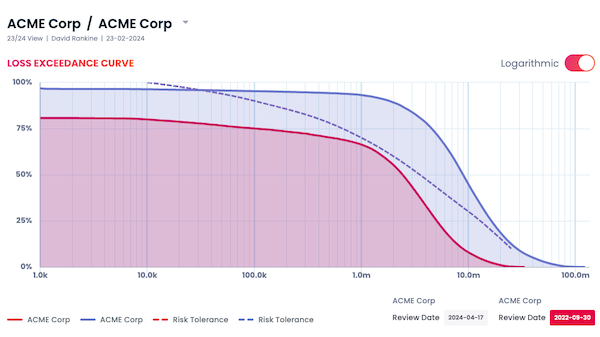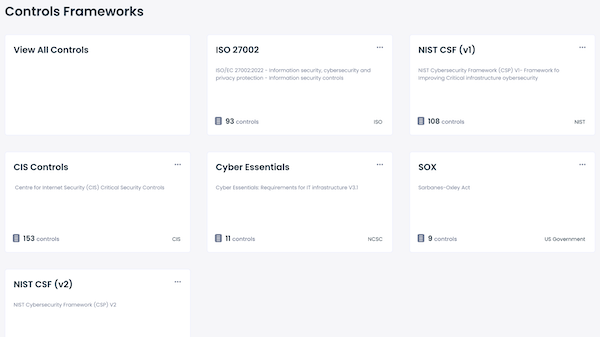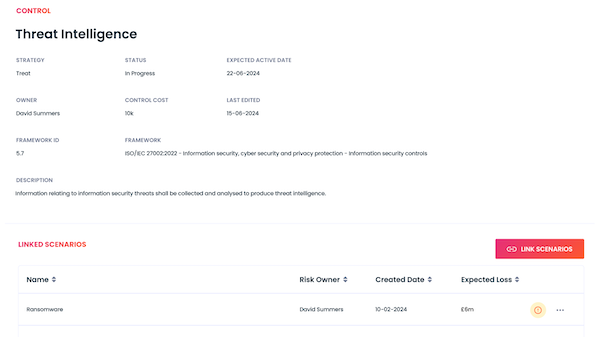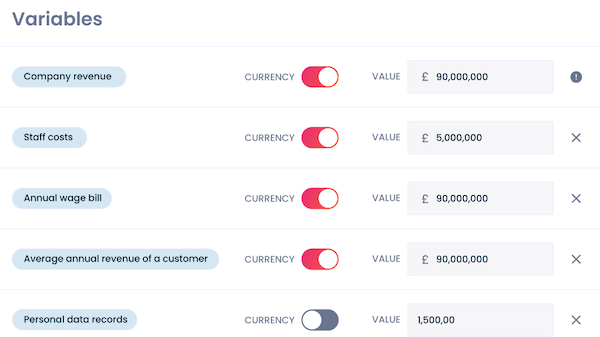Track your risk, manage your programme, and know what's next. All in one place.
Quantify your risk, access risk intelligence, and build your programme in minutes, not months.
Companies we work with




Helping you to...

Improve cyber risk conversations
Talk about cyber risk in monetary terms that stakeholders understand, rather than using uncertain terms like ‘likely’ or ‘amber’.

Learn from security incidents
Use real data, from real events, to improve your risk analysis. Practice continual improvement to refine the consequence and frequency of risks.

Comply with frameworks
Easily map risks to the controls you put in place. Align those controls to the common control frameworks that your business cares about. Easily collate evidence.

Justify cyber security spending
Build a transparent view of cyber economics. Compare the cost of risk mitigation with the likelihood of financial loss and business risk appetite.

Link cyber risk to business objectives
Calculate risk from easily obtainable business metrics. Project future risk based on business performance and forthcoming plans.

Collaborate on cyber risk across the organisation
Avoid tracking risk activities in sprawling spreadsheets, emails and document management systems. Invite collaborators to input data into a lightweight tool, and export what matters for those not involved day-to-day.
Frequently Asked Questions
Recognise that the status quo for Cyber Risk Management isn’t good enough? Want to know more?
The risk platform helps security teams, IT Directors, CISOs, risk managers and business leaders understand, measure and act on cyber risk, and then improve their approach over time. The challenges each of these groups face are often the same - just viewed from a different perspective.
If you manage cyber risk, or work with the person managing your company’s cyber risk, you’ll know they are often hard at work gathering risk data. But it’s difficult for them to do the really valuable work of interpreting and recommending. It can also be a struggle to ‘just hit refresh’ to get the latest view, especially when you really need the insight at short notice.
We’ve made the risk platform a single place to view, navigate and interpret risk data in multiple ways, allowing your risk manager to concentrate on ensuring fidelity and interrogating the results for cross-functional teams. We do this by structuring the data for ease of navigation and communication - meaning you and your team spend less time trying to decipher complicated spreadsheets, and more time working out how to tackle the challenge.
Sorting through all the data in order to explain it to everyone that needs to know about it, in terms that work for them, is a challenge. If you’re using 5x5 grids, you’ll likely already understand the shortcomings when it comes to communicating and understanding the impacts of cyber risk. Translating assessments into financial impact creates clarity.
We know from multiple projects that the best way to talk about the impact of cyber risk is to talk about - and address - risk in fiscal terms. Reducing a risk by 5% of annual revenue rather than from ‘High’ to ‘Medium’ gives clarity to conversations that can be fraught with nuance.
The Cydea risk platform is built for top-down information gathering and interpretation, so everyone in your organisation from board members, CISOs and IT directors, through to risk managers and IT security staff, can understand cyber risk indicators in terminology that is relevant to their role. Insights are presented in metrics and quantities, rather than subjective language that might be at risk of misinterpretation.
Talking risk can be like a game of ‘telephone’ in any organisation - what one group sees as a clear signal of warning, opportunity or reassurance can mean something completely different to another team, even while you’re all pushing for the same result.
The risk platform delivers insights when you need them – not just when they’re ready. In turn, this is then interpreted for the audience, in the format that fits the standards, regulations or frameworks they may need to interrogate them against.
It’s a refrain familiar to anyone in cyber security: “We can’t tell if the stuff we’ve paid for actually mitigates risk!“ It’s entirely normal for this to happen, often for multiple reasons. It’s difficult to figure out next steps, or whether tools or solutions need to be retired or repurposed.
Using the risk platform, everyone - from the risk manager up to the chairman of the board - gets a clear picture of the organisation’s cyber risk profile, and the means to model how changes will affect it. It’s also much more straightforward to work out where to invest, and which investments are paying off.
If your cyber risk tracker started out as a spreadsheet, there’s a chance it’s morphed into a monster no-one can control or fully understand. It doesn’t really meet regulatory compliance expectations, or play well with other tools or dashboards. No one likes it when the spreadsheet is in charge.
Our risk platform quantifies cyber risk, works well with existing tools, and meets regulatory compliance requirements. It gives clear answers and quantifies conclusions in terminology that explains in monetary terms the impact of risk and mitigations.
A better way to understand cyber risk
It’s vital to know the real risks your organisation faces and to understand if your organisation has strategies to tackle them effectively.
To understand and manage your cyber risk, you need consistent data, insight and collaboration across your business, in order to:
- Employ a top-down approach to risk identification
- Use common risk scenarios and populate them with your data - or upload your existing register
- Share an accurate view or risk in days, not months
- Build feedback loops to learn from incidents
- Demonstrate how your treatment proposals and plans will manage risks
- Communicate risk in language your business understands